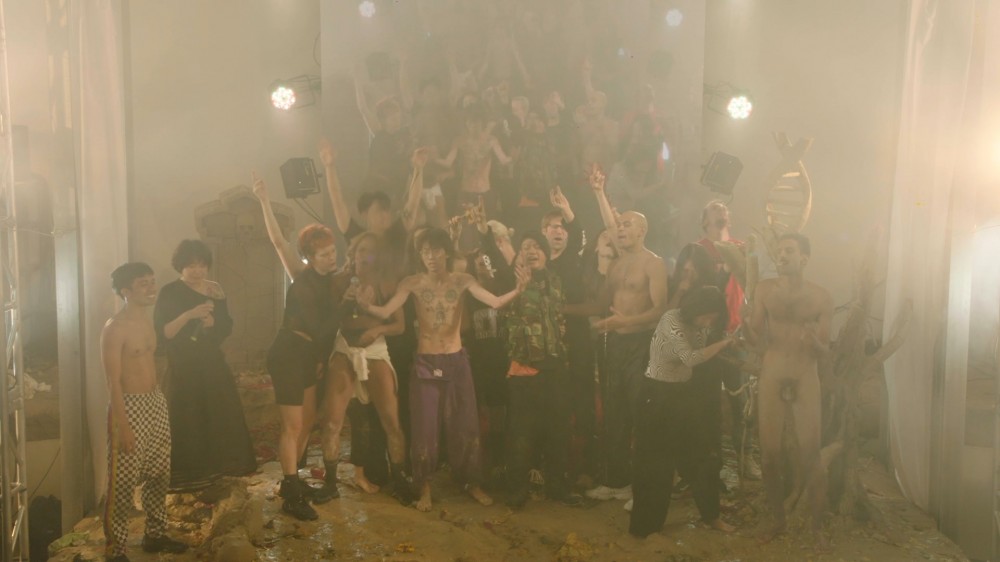
Fact Residency: Tianzhuo Chen
Tianzhuo Chen explores the connections between the physical limits of the human body and the potential, through performance, for emotional and spiritual transformation.
In all of his work, Tianzhuo Chen explores the connections between the physical limits of the human body and the potential, through performance, for emotional and spiritual transformation. Deeply influenced by his Tibetan Buddhist beliefs, in the context of his work this liminality manifests as a continuous dialogue between the mortal and the divine, a relationship which is brought to vivid life in the worlds Chen creates. In The Dust the ceremonial instruments used to establish these lines of communication between gods and humans are themselves elevated to protagonists, granted agency in the video work’s disembodied narrative, while in Trance gods and humans exist in the same aesthetic realm, moving to the same rhythm.
33EMYBW, Gabber Modus Operandi and City provide Chen with a melodic framework within which the artist can conduct this exploration, shedding light on the absurdity and disorder of human existence in order to reveal fundamental truths about our collective potential. In much the same way as prayer wheels and statues of Buddhist deities symbolise humankind’s connection to the divine in The Dust, in Trance bodies exist as conduits, vessels for the spirits of writers, philosophers and gods that are invoked by the artist as part of the ritualistic practice of the performance. This is what Antonin Artaud alludes to when he describes “a body which undergoes the world, and disgorges reality,” an entity capable of making it through the Sisyphean task of living in the physical world with the ability to speak of both life and death, as well as that which might exist in-between.
While these works might begin life as melodies that reverberate around the artist’s head, the end result is work of and for the body, art rituals in which all who participate, whether performer or spectator, experience physical and psychic transformation. The work of Tianzhuo Chen invokes the immanence of the body while gesturing towards its inherent potential to transcend past its physical limitations, envisaging a new kind of physicality, in a new kind of world.
Tianzhuo Chen Presents: The Dust
In Chen’s new work, ‘The Dust’, commissioned by Beijing’s Macalline Art Center, the artist’s demand to get beyond the body leads him to consider what the performative aspects of ritual and ceremony look like in the absence of human beings. Situating ceremonial objects, farming tools, vultures, which have special significance in Tibetan Buddhism, and the landscape around Cuogao Village and Damu Templein the Nagqu District of Tibet as the work’s primary protagonists, Chen positions the human condition as inherently Sisyphean. He documents the instruments of mankind’s struggle to atone for original sin, moving from remnants of ancient life and images of natural beauty to water-powered prayer wheels, the wreckage of industrial machinery and rows of human skulls. Chen reveals a world in disorder, objects and instruments linked together by the absurd logic of chaos and creation. “In a universe suddenly divested of illusions and lights, man feels an alien, a stranger,” writes Albert Camus in The Myth of Sisyphus. “This divorce between man and his life, the actor and his setting, is properly the feeling of absurdity.”
It is this sense of absurdity, that can be understood as stemming from the separation of ritual and ceremony from the body, that Chen addresses with The Dust. Inspired by the funeral ritual of the sky burial, in which the deceased is left out in the elements to be scavenged by the birds, the short film was captured during a week-long religious retreat. According to the beliefs of Vajrayana Buddhism, at the point of death the spirit leaves the body, leaving its corporeal form as an empty vessel: meat for the birds that will eventually return to the dust. In this way Chen responds to Camus’s assertion that “it is barely possible to speak of the experience of others’ deaths. It is a substitute, an illusion, and it never quite convinces us.” Over the course of The Dust the artist maps the experience of death and rebirth, beginning with the water and mud of the earth and ending in the sky, blown about by the mountain winds. For Chen this is what remains in the absence of the human, as writer and academic Oxi Pëng puts it in a poem accompanying the film: “there is no such species / called ‘human’. / but only the prayers’ everlasting dreams, / flowing into the heart of the earth.”
Observing the instruments of ritual, separated from the context of social religious interaction, it is music that guides us through this deserted landscape, filling the void left by human absence. Glistening peels of electronic chimes and gongs give way to lurching synth swells in the film’s stunning score from SVBKVLT artist 33EMYBW, which bookends a field recording made by Chen of a Buddhist ceremony he was permitted to document. Setting the sounds of religious practice predicated on the observance of the body against various images of death – skulls, stuffed animals, vultures – Chen subverts the illusion of the experience of death, instead tracing a map of its material reality. When the flesh has decomposed to dust what remains are the prayers of those who are left behind, as well as the music they play in remembrance, or as Oxi Peng describes it: “the mystic organ that grinds the silver wind / penetrated by the forgotten memories of the unknown.”
Tianzhuo Chen Presents: Trance (Gabber Modus Operandi Edit)
In many ways, Trance is the culmination of all of Tianzhuo Chen’s work thus far, drawing together the varied and multitudinous aspects of the artist’s wide-ranging practice. Stretching across 12 continuous hours and featuring a sprawling cast, Trance brings together a collection of self-taught and professional performers that spend every minute in character, eating, resting and even going to the bathroom amidst the sculptures, sand and raw clay of Chen’s stage. A musical ensemble that includes Dis Fig, Ican Harem of Gabber Modus Operandi, whose stunning track ‘Trance Adiluhunxx’ scores the above short film, ¥ØU$UK€ ¥UK1MAT$U, Felix-Florian Todtloff and City act as guides for the gathered audience, who over time are invited to participate in the performance ritual, merging with those on stage in a rapturous climactic celebration.
Inspired both by Antonin Artaud’s Theatre of Cruelty and traditional Tibetan Buddhist ceremonies, Trance is a sustained and focused investigation into physicality and the corporeal limits of the body, as well a space for those who participate in the performance to approach literal trance states, instances of intense psychic liberation that allow for a return to a primitive connection with the material world. During the course of the performance the movements of those on stage are captured and played back to the audience in slow-motion, enabling highly detailed studies of physical movement. The extreme duration of the performance is also accentuated by the lysergic set dressing, as the fresh flowers, vegetation and wet clay that make up the stage at the start of the performance eventually wilt, rot and crack over time, a process of entropy that mirrors the somatic and mental transformations experienced by participants in the piece.
Trance was premiered back in 2019 at Beijing’s M. Woods Gallery, taking place over three iterations on three consecutive days. The narrative of each performance unfolds in two-hour cycles and is split over six chapters, each drawing on a wild variety of texts and artworks dealing with various conceptions of death and apocalypse. Starting with a meditation on a series of Japanese paintings from the 14th century depicting the nine phases of death according to the Mahayana sutras, the performance moves through phases inspired by Susan Sontag’s 1967 novel Death Kit, William Blake’s Songs of Innocence and Experience, a hip-hop adaptation of lines taken from Delog: Journey to Realms Beyond Death, a key Buddhist text from Delog Dawa Drolma, as well as a sequence of movement responding to the paranoid letters sent by Antonin Artaud during his mysterious trip to Ireland in 1937, when he set off to chase terrible revelations about the end of the world which he believed to be fast approaching.
Tianzhuo Chen Presents: Trance – Behind The Scenes (City Edit)
Over the course of the 12-hour duration of Tianzhuo Chen’s latest performance work, Trance, the artist captures the movements of the performers and musicians gathered on the stage in order to document physical and emotional changes that occur over time. As the performance ritual continues he plays back this hyper-detailed footage in slow motion, allowing the audience to shift their perspective of the work in both time and space. These small, self-contained moments of audiovisual time travel open new portals into the work, opportunities to dive deeper into the ritual and experience the intimacy and ecstasy of those in the trance.
Musicians Dis Fig, Ican Harem of Gabber Modus Operandi, City, ¥ØU$UK€ ¥UK1MAT$U and Felix-Florian Todtloff are joined by choreographer Ylva Falk, rapper KNG KHAN and a host of professional and self-taught performers, including Bidjé de Rosa, Lavinia Vago, Lisette Ros, Ndoho Ange, Omid Tabari and Siko Setyanto. Inhabiting different characters during each of the performance’s six chapters, our focus shifts between the performers, who take turns leading the ceremony, guiding the group in the transformative process of the ritual.
In the behind the scenes footage, Chen weaves together this slow-motion documentation in a sustained study of physical experimentation and exploration. Returning full circle from The Dust, a work that considers what ritual and ceremony looks like in the absence of the body, Chen strips away everything but the corporeal, presenting Trance as it plays out across the bodies of his cast.
Music devised specifically for the performance by City can be heard in the documentation. Punctuated by moments of silence, the melodic core of Chen’s work is highlighted in this slow-motion sequence, the visual component of the work taking on an elongated, ambient quality, leaving space for the monolithic theatricality of City’s score. Moments of surging percussion and grandiose synths swirl into dense banks of noise before fading away, ceding space to melancholic drones and gentle, effects-heavy guitar.
The European premiere for Trance is coming soon. For more information about Tianzhuo Chen and his work you can visit his website and follow him on Instagram.



